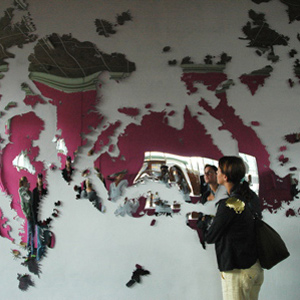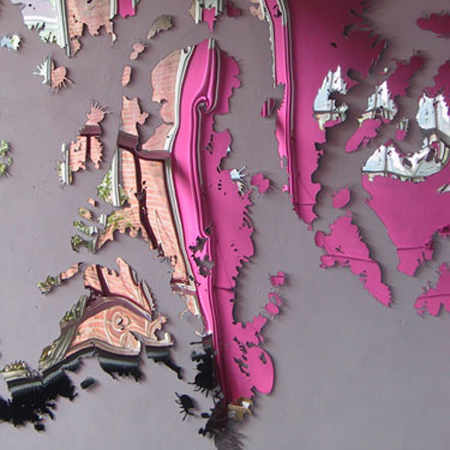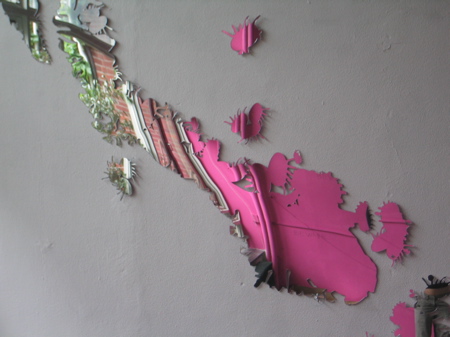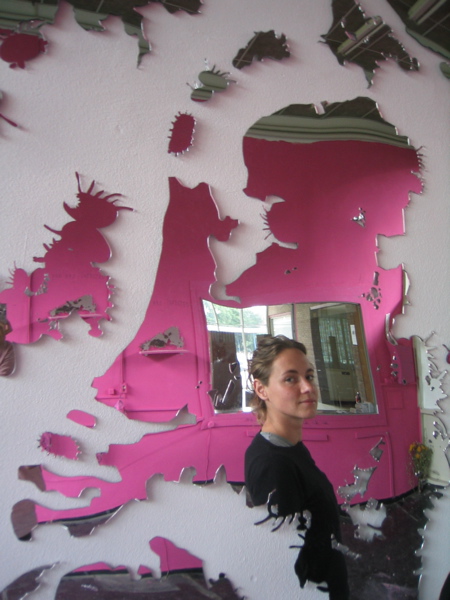
Mirror Virus by Pieke Bergmans
Milan update: young Dutch designer Pieke Bergmans showed elements of her Design Virus project across Milan this year, including these mirrors at the prestigious Dilmos Gallery.

Mirror Virus - Utopia Infected presents a mirrored map of the world that has been distorted by viruses.

Bergmans also showed variations on the original Design Virus concept she presented last year - crystal vases that are blown directly onto existing items of furniture to become part of, while partially destroying their host - their host - at other venues in Milan.

Below is Bergmans' explanation of the virus concept, plus a biography:
--
The Mirror Virus resembles the world map. Its countries and continents have been thoroughly deformed and re-arranged, infected by a virus. With its countries combined in new ways and borders neglected, could this be a better world? Looking at the work, you find yourself reflected in all parts of the planet.
And a mirror of course works two ways; it is not just the planet that is distorted, but also your reflection. “Beware, you are infected!" It makes sense; when you look in one of these mirrors, you see a distorted, infected image of yourself.
Reflection = Infection.
--
Pieke Bergmans is a young industrial designer from Holland. She has studied at the Academy of Arts, St. Joost Breda (graphic design). HKA-Art-School Arnhem (3D-Design). Design Academy Eindhoven (Industrial Design). Royal College of Art, London (MA, Design Products). She worked around Europe doing a large variety of projects. Her favourite modus operandi is to alter existing production processes to come to new forms and functions.
Pieke’s work is spontaneous, playful and fresh. She aims to combine function, form and message in a single elegant gesture. Whether working with porcelain, plastic or glass, she always creates objects that are of a pure and natural beauty.
Diversity is one of her significant trademarks. She finds inspiration and opportunity in each industry and in every different material. In cooperation with companies such as Rosenthal and Swarovski, Pieke explores the possibilities of their production facilities, and manipulates them. The goal is to make ‘personalized mass production’ where irregularities are ruled in.
“No two people are the same, and neither are two of the hairs that grow on your head. I wish our products were a bit more like this as well. The next step in mass production could be controlled imperfect production, for interesting, personal objects."
Pieke Bergmans works with a wide range of materials and has no preference for the use of them. “I explore materials and I’m curious about what they can do. From that angle, a product comes to life. I take peeks in foreign kitchens and let myself be inspired by what I see and experience. I also take the time to research and experiment. My designs depend on what I find along the way. I have an unstoppable curiosity for new ways to find and create form."
A central theme in Pieke’s work is the virus. It binds the many disciplines and materials with which she creates products and works of art.
‘I am a virus’
Pieke’s products are called viruses, due to their natural forms and the way they come to life. But eventually, the biggest virus of them all is the designer in person. Manipulating standard production processes is by all means viral behaviour. In general mass production, a single form is endlessly and perfectly multiplied like a healthy cell. As she allows room for change and serendipity, Pieke aims to create processes in which products are never completely the same. Like a virus, her products change and adapt to various conditions, disrupting common ideas and the predictable evolution of form and design.
The Design Virus will spread and become a global epidemic. Beware – You will be infected.
We find viruses in many different places. In fact, every specific subject with a true culture of its own is subdued to the forming of viruses sooner or later. It simply is the nature of nature. It seems that ‘design’ has finally become a virus victim as well. As is usual with viruses, when they strike, they strike hard and in many different ways. As we speak, a large variety of viruses attack all existing forms of design.
The weak spots of the victim quickly come to light: symmetry, monotony, repetition, mass production and mass distribution. Though most viruses have highly destructive capacities, they often seem to only parasite their subjects or disrupt their common features. Today, the appearance of these viruses seems to have triggered the admiration of many, but the fear of few. That could be the reason why a cure to any of these viruses has not yet been found.
--
See all dezeen's coverage of Milan 2007 here